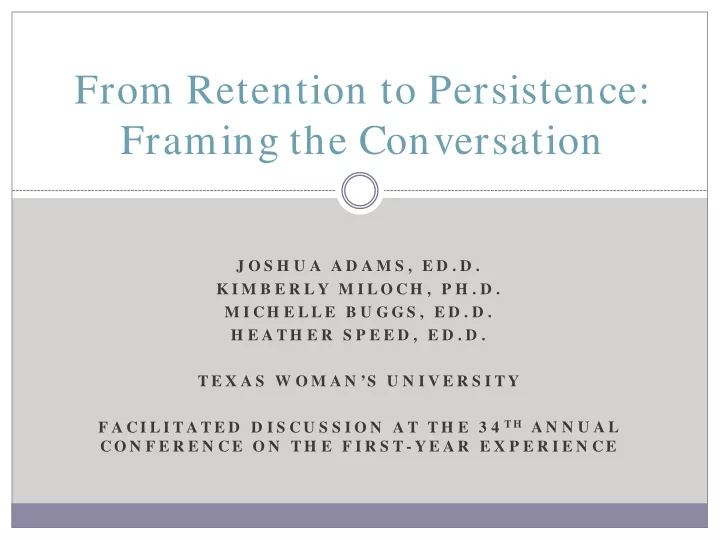

From Retention to Persistence: Framing the Conversation J O S H U A A D A M S , E D . D . K I M B E R L Y M I L O CH , P H . D . M I CH E L L E B U G G S , E D . D . H E A T H E R S P E E D , E D . D . T E X A S W O M A N ’S U N I V E R S I T Y F A C I L I T A T E D D I S C U S S I O N A T T H E 3 4 T H A N N U A L C O N F E R E N C E O N T H E F I R S T - Y E A R E X P E R I E N C E
Session Agenda Overview of Literature on Persistence and Retention Definitions of Retention Definitions of Persistence Top Practices Assessment of Practices Alignment of Practices Action Plans
Overview of Literature: Retention Six-year graduation rates have remained relatively stable (50%) Policy focus has not made a significant impact on attrition rates Increasing diversity of student body could be one factor contributing toward less positive movement in retention percentages. Can be viewed as an organizational phenomenon Astin’s (1993) I-E-O model
Overview of Literature: Persistence Can be viewed as an individual phenomenon Focus on goal-attainment Term is often used interchangeably with retention Tinto’s theory of student departure
What is Retention? Retention (noun): The act of keeping someone or something
What is Persistence? Persistence (noun): The quality that allows someone to continue doing something or trying to do something even though it is difficult or opposed by other people
Discussion Questions Is there a difference between retention and persistence? How do we bring these overall definitions in to a higher education context?
Your Definition Given your specific institutional role and context, develop your own definition of retention and persistence.
Retention Practices List 3-5 key retention practices you engage in at your institution How do you assess and measure these initiatives?
The Third Column Given your personal definition of retention and persistence, do your retention practices align with that definition?
Developing an Action Plan What are next steps for continuing the conversation at your institution?
References Astin, A. W. (1993). What matters in college? San Francisco: Jossey-Bass. Berkener, L., He, S., & Cataldi, E.F. (2002). Descriptive summary of 1995-96 beginning postsecondary students: Six years later (NCES 2003-151). Washington, DC: National Center for Educational Statistics. Braxton, J. M., Breier, E. M., & Steele, S. L. (2007). Shaping retention from research to practice. Journal of College Student Retention, 9, 377-399. Habley, W.R., McClanahan, R., Valiga, M., & Burkum K. (2010). What works in student retention. Iowa City: ACT. Habley, W.R., Bloom, J.L., & Robbins, S. (2012). Increasing persistence: Research- based strategies for college student success. San Francisco: Jossey-Bass. Reason, R. D. (2009). An examination of the persistence research through the lens of a comprehensive conceptual framework. Journal of College Student Development, 50, 659-682. Renn, K. A., & Reason, R. D. (2013). College students in the United States: Characteristics, experiences, and outcomes. San Francisco: Jossey-Bass. Tinto, V. (1993). Leaving college: Rethinking the causes and cures of student attrition. Chicago: University of Chicago Press.
Recommend
More recommend